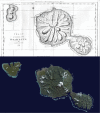Towards a Global Names Architecture: The future of indexing scientific names
- PMID: 26877664
- PMCID: PMC4741226
- DOI: 10.3897/zookeys.550.10009
Towards a Global Names Architecture: The future of indexing scientific names
Abstract
For more than 250 years, the taxonomic enterprise has remained almost unchanged. Certainly, the tools of the trade have improved: months-long journeys aboard sailing ships have been reduced to hours aboard jet airplanes; advanced technology allows humans to access environments that were once utterly inaccessible; GPS has replaced crude maps; digital hi-resolution imagery provides far more accurate renderings of organisms that even the best commissioned artists of a century ago; and primitive candle-lit microscopes have been replaced by an array of technologies ranging from scanning electron microscopy to DNA sequencing. But the basic paradigm remains the same. Perhaps the most revolutionary change of all - which we are still in the midst of, and which has not yet been fully realized - is the means by which taxonomists manage and communicate the information of their trade. The rapid evolution in recent decades of computer database management software, and of information dissemination via the Internet, have both dramatically improved the potential for streamlining the entire taxonomic process. Unfortunately, the potential still largely exceeds the reality. The vast majority of taxonomic information is either not yet digitized, or digitized in a form that does not allow direct and easy access. Moreover, the information that is easily accessed in digital form is not yet seamlessly interconnected. In an effort to bring reality closer to potential, a loose affiliation of major taxonomic resources, including GBIF, the Encyclopedia of Life, NBII, Catalog of Life, ITIS, IPNI, ICZN, Index Fungorum, and many others have been crafting a "Global Names Architecture" (GNA). The intention of the GNA is not to replace any of the existing taxonomic data initiatives, but rather to serve as a dynamic index to interconnect them in a way that streamlines the entire taxonomic enterprise: from gathering specimens in the field, to publication of new taxa and related data.
Keywords: Biodiversity Data; Carl Linnaeus; Charles Davies Sherborn; Global Names Index; Global Names Usage Bank; Taxonomy; ZooBank Biodiversity Library.
Figures









Similar articles
-
A common registration-to-publication automated pipeline for nomenclatural acts for higher plants (International Plant Names Index, IPNI), fungi (Index Fungorum, MycoBank) and animals (ZooBank).Zookeys. 2016 Jan 7;(550):233-46. doi: 10.3897/zookeys.550.9551. eCollection 2016. Zookeys. 2016. PMID: 26877662 Free PMC article.
-
PESI - a taxonomic backbone for Europe.Biodivers Data J. 2015 Sep 28;(3):e5848. doi: 10.3897/BDJ.3.e5848. eCollection 2015. Biodivers Data J. 2015. PMID: 26491393 Free PMC article.
-
Ten years and a million links: building a global taxonomic library connecting persistent identifiers for names, publications and people.Biodivers Data J. 2023 Sep 14;11:e107914. doi: 10.3897/BDJ.11.e107914. eCollection 2023. Biodivers Data J. 2023. PMID: 37745899 Free PMC article.
-
Plant Taxonomy: A Historical Perspective, Current Challenges, and Perspectives.Methods Mol Biol. 2021;2222:1-38. doi: 10.1007/978-1-0716-0997-2_1. Methods Mol Biol. 2021. PMID: 33301085 Review.
-
DNA barcoding and taxonomy: dark taxa and dark texts.Philos Trans R Soc Lond B Biol Sci. 2016 Sep 5;371(1702):20150334. doi: 10.1098/rstb.2015.0334. Philos Trans R Soc Lond B Biol Sci. 2016. PMID: 27481786 Free PMC article. Review.
Cited by
-
The List of Available Names (LAN): A new generation for stable taxonomic names in zoology?Zookeys. 2016 Jan 7;(550):225-32. doi: 10.3897/zookeys.550.10043. eCollection 2016. Zookeys. 2016. PMID: 26877661 Free PMC article.
-
Challenges with using names to link digital biodiversity information.Biodivers Data J. 2016 May 25;(4):e8080. doi: 10.3897/BDJ.4.e8080. eCollection 2016. Biodivers Data J. 2016. PMID: 27346955 Free PMC article. No abstract available.
-
Digitising legacy zoological taxonomic literature: Processes, products and using the output.Zookeys. 2016 Jan 7;(550):189-206. doi: 10.3897/zookeys.550.9702. eCollection 2016. Zookeys. 2016. PMID: 26877659 Free PMC article.
-
A novel curation system to facilitate data integration across regional citizen science survey programs.PeerJ. 2020 Jul 29;8:e9219. doi: 10.7717/peerj.9219. eCollection 2020. PeerJ. 2020. PMID: 32821528 Free PMC article.
-
Arctos: Community-driven innovations for managing natural and cultural history collections.PLoS One. 2024 May 31;19(5):e0296478. doi: 10.1371/journal.pone.0296478. eCollection 2024. PLoS One. 2024. PMID: 38820381 Free PMC article.
References
-
- Bates HW. (1863) The naturalist on the River Amazons, a record of adventures, habits of animals, sketches of Brazilian and Indian life and aspects of nature under the Equator during eleven years of travel (volume 1). J. Murray, London: [1892], 351 pp. doi: 10.5962/bhl.title.21335 - DOI
-
- Bean TH. (1903) Catalogue of the fishes of New York. Bulletin New York State Museum 60: 1–784. doi: 10.5962/bhl.title.23134 - DOI
-
- Chapman AD. (2009) Numbers of Living Species in Australia and the World (2nd edition). Australian Biological Resources Study, Australia: http://www.environment.gov.au/biodiversity/abrs/publications/other/speci...
-
- Chmielewski JG, Krayesky D. (2013) General Botany Laboratory Manual. AuthorHouse, Bloomington, Indiana, 300 pp.
-
- Costello MJ, Wilson S, Houlding B. (2012) Predicting total global species richness using rates of species description and estimates of taxonomic effort. Systematic Biology 61(5): 871–883. doi: 10.1093/sysbio/syr080 - DOI - PubMed
LinkOut - more resources
Full Text Sources
Other Literature Sources
